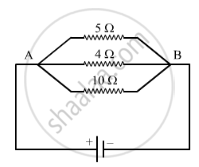Advertisements
Advertisements
प्रश्न
A potential difference of 20 volts is applied across the ends of a resistance of 5 ohms. What current will flow in the resistance?
उत्तर
Here,
Potential difference, V = 20 V
Resistance, R = 5 Ω
Substituting these values in Ohm's equation, V/I = R:
Current, I = V/R = 20/5 = 4 A
Thus, the current flowing in the circuit is 4 A.
APPEARS IN
संबंधित प्रश्न
State two causes of energy loss in a transformer.
What is meant by saying that the electric potential at a point is 1 volt?
How much work is done in moving a charge of 2 C across two points having a potential difference of 12 V?
For the circuit shown in the diagram below:

What is the value of:
(i) current through 6 Ω resistor?
(ii) potential difference across 12 Ω resistor?
In the circuit diagram given below, the current flowing across 5 ohm resistor is 1 amp. Find the current flowing through the other two resistors.

If the potential difference between the ends of a fixed resistor is halved, the electric power will become:
Three electric cells of potential difference 1.5 V each have been connected as a battery. The potential differences of the battery will be ____________ V.
Two bulbs are marked 100 W, 220 V and 60 W, 110 V. Calculate the ratio of their resistances.
______ is work done per unit charge.
